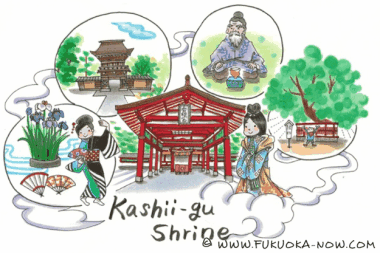Hakata Culture vol.88
Kashii-gu: A Shrine with Close Ties to the Imperial Court

Located in Higashi-ku, Kashii-gu Shrine is one of the oldest Shinto shrines in Japan. According to legend, Empress Jingu had a shrine built in the year 200 in honor of her husband, Emperor Chuai, who died here. Several centuries later, the shrine was also dedicated to Empress Jingu and Emperor Ojin, the son of Emperor Chuai and Empress Jingu, and came to be known as Kashii-gu.
These three emperors are considered legendary since historians have been unable to verify whether or not they existed, but Kashii-gu still maintains close ties to the imperial court. Even now, the Emperor sends an imperial envoy to visit Kashii-gu once every 10 years, making it one of only 17 shrines in Japan where such visits are made. To date, Kashii-gu has welcomed 138 imperial envoys, and the next visit is scheduled for 2015. The approach to the shrine, which is known as Imperial Envoy Road, is lined with 165 beautiful camphor trees, one from each of the 165 past and present municipalities in the prefecture.
The main hall was built using Kashii-zukuri, a unique architectural style that can only be found at Kashii-gu Shrine. The current shrine dates back to 1801, when Nagayori Kuroda (also known as Narikyo Kuroda), the 10th lord of Chikuzen Province, commissioned its reconstruction. (The original was supposedly much larger.) The spacious grounds are home to the Ayasugi, a massive Japanese cedar that is said to have been planted by Empress Jingu herself, as well as an exquisite romon, or tower gate. There is also a water iris pond, which blooms during the rainy season, and an iris festival is held on the second weekend of every June.
There are several subordinate shrines on the premises of Kashii-gu, one of which is dedicated to Takenouchi no Sukune, a legendary hero who supposedly lived for nearly 300 years and served five imperial courts. The secret to his longevity was a nearby well of eternal youth. Visitors can still drink from the same well, a five-minute walk from the shrine, in hopes of fending off old age. It has also been selected as one of the top 100 renowned water sources in Japan.
The next time you’re in Higashi-ku, be sure to stop by Kashii-gu Shrine.
天皇からの使者が遣わされる香椎宮
福岡市東区にある香椎宮は、全国でもとても歴史が古い神社のひとつです。仲哀天皇9(200)年、神功皇后がこの地で亡くなった夫・仲哀天皇を祀る祠を建てたのが起源とされています。その後、神功皇后、さらにその息子である応神天皇も祀られるようになり、のちに香椎宮と呼ばれるようになりました。
このような由来から皇室とは非常にゆかりの深い神社でもあります。現在でも天皇からのお使いである勅使(ちょくし)がお出でになる勅祭が10年に一度行われています。勅祭が行われる神社は伊勢神宮をはじめ全国に17社しかありません。香椎宮ではこれまでに138回の勅祭が行われ、次回は平成27年に勅使が遣わされることになっています。また見事なクスノキが生い茂る参道は「勅使道」と呼ばれ、勅使が通る道として県下165の市町村(当時)が1本ずつクスノキを献上したそうです。
本殿は「香椎造り」と呼ばれる日本ではここだけにしか見られない独特の建築様式。現在の社殿は享和元(1801)年に筑前藩主黒田長順(ながより)公(後に黒田斉清(なりきよ)と改名)が再建したもので、以前はもっと大きな社殿だったそうです。広々とした境内には神功皇后が植えたと伝わる御神木「綾杉」や立派な楼門もあります。また梅雨時に美しい花を咲かせる菖蒲池があり、毎年6月の第2土・日曜には「扇としょうぶ祭」が行われています。
香椎宮にはたくさんの末社がありますが、そのひとつが武内宿禰(たけうちのすくね)を祀った武内神社。300年の長寿を保ち、5つの朝廷に仕えたという人物です。その長寿の秘密が香椎宮から歩いて5分ほどの不老水。ここの水を飲んでいたから武内宿禰は長生きだったとされ、不老長寿の霊泉として日本名水百選にも選ばれました。ぜひ香椎宮と一緒に訪れてみてください。

